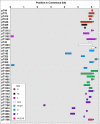Heads or tails: L1 insertion-associated 5' homopolymeric sequences
- PMID: 20226075
- PMCID: PMC2837659
- DOI: 10.1186/1759-8753-1-7
Heads or tails: L1 insertion-associated 5' homopolymeric sequences
Abstract
Background: L1s are one of the most successful autonomous mobile elements in primate genomes. These elements comprise as much as 17% of primate genomes with the majority of insertions occurring via target primed reverse transcription (TPRT). Twin priming, a variant of TPRT, can result in unusual DNA sequence architecture. These insertions appear to be inverted, truncated L1s flanked by target site duplications.
Results: We report on loci with sequence architecture consistent with variants of the twin priming mechanism and introduce dual priming, a mechanism that could generate similar sequence characteristics. These insertions take the form of truncated L1s with hallmarks of classical TPRT insertions but having a poly(T) simple repeat at the 5' end of the insertion. We identified loci using computational analyses of the human, chimpanzee, orangutan, rhesus macaque and marmoset genomes. Insertion site characteristics for all putative loci were experimentally verified.
Conclusions: The 39 loci that passed our computational and experimental screens probably represent inversion-deletion events which resulted in a 5' inverted poly(A) tail. Based on our observations of these loci and their local sequence properties, we conclude that they most probably represent twin priming events with unusually short non-inverted portions. We postulate that dual priming could, theoretically, produce the same patterns. The resulting homopolymeric stretches associated with these insertion events may promote genomic instability and create potential target sites for future retrotransposition events.
Figures





Similar articles
-
Twin priming: a proposed mechanism for the creation of inversions in L1 retrotransposition.Genome Res. 2001 Dec;11(12):2059-65. doi: 10.1101/gr.205701. Genome Res. 2001. PMID: 11731496 Free PMC article.
-
Insertion and deletion polymorphisms of the ancient AluS family in the human genome.Mob DNA. 2017 Apr 24;8:6. doi: 10.1186/s13100-017-0089-9. eCollection 2017. Mob DNA. 2017. PMID: 28450901 Free PMC article.
-
Internal priming: an opportunistic pathway for L1 and Alu retrotransposition in hominins.Gene. 2009 Dec 15;448(2):233-41. doi: 10.1016/j.gene.2009.05.014. Epub 2009 Jun 6. Gene. 2009. PMID: 19501635 Free PMC article.
-
A systematic analysis of LINE-1 endonuclease-dependent retrotranspositional events causing human genetic disease.Hum Genet. 2005 Sep;117(5):411-27. doi: 10.1007/s00439-005-1321-0. Epub 2005 Jun 28. Hum Genet. 2005. PMID: 15983781 Review.
-
Biology of mammalian L1 retrotransposons.Annu Rev Genet. 2001;35:501-38. doi: 10.1146/annurev.genet.35.102401.091032. Annu Rev Genet. 2001. PMID: 11700292 Review.
Cited by
-
Retrotransposon instability dominates the acquired mutation landscape of mouse induced pluripotent stem cells.Nat Commun. 2022 Dec 3;13(1):7470. doi: 10.1038/s41467-022-35180-x. Nat Commun. 2022. PMID: 36463236 Free PMC article.
-
Investigating mobile element variations by statistical genetics.Hum Genome Var. 2024 May 30;11(1):23. doi: 10.1038/s41439-024-00280-1. Hum Genome Var. 2024. PMID: 38816353 Free PMC article. Review.
-
Dispersal of an ancient retroposon in the TP53 promoter of Bovidae: phylogeny, novel mechanisms, and potential implications for cow milk persistency.BMC Genomics. 2015 Feb 5;16(1):53. doi: 10.1186/s12864-015-1235-8. BMC Genomics. 2015. PMID: 25653076 Free PMC article.
-
Genotyping of Transposable Element Insertions Segregating in Human Populations Using Short-Read Realignments.Methods Mol Biol. 2023;2607:63-83. doi: 10.1007/978-1-0716-2883-6_4. Methods Mol Biol. 2023. PMID: 36449158
-
A unified framework to analyze transposable element insertion polymorphisms using graph genomes.Nat Commun. 2024 Oct 16;15(1):8915. doi: 10.1038/s41467-024-53294-2. Nat Commun. 2024. PMID: 39414821 Free PMC article.
References
Grants and funding
LinkOut - more resources
Full Text Sources
Other Literature Sources

